Hey 👋… This post is reader-supported. Clicking links might earn me a small commission at no extra cost to you.
In my 3+ years of writing, I’ve realized that nothing beats having a professional human editor. Still, editing software like Grammarly and ProWritingAid are incredibly useful to writers at all levels, especially if you’re still honing your self-editing skills and can’t afford to hire a professional editor.
As of this writing, I’ve been a Grammarly Premium user for over two years and a ProWritingAid Premium user for about three weeks. Both editing software can catch elusive but embarrassing grammar mistakes, polish your content, and even sharpen your writing skills.
This article compares Grammarly vs ProWritingAid based on my experience of using the free and paid version of both tools. After reading, you’ll be able to determine which of the two editing software is best for you.
Note: Both editing tools have desktop apps, web editors, and online plugins. But I used their web editors for my illustrations throughout this article.
Our verdict
Grammarly is the best and most expensive grammar checker. ProWritingAid is a great grammar checker and a super-affordable Grammarly alternative. We use ProWritingAid because it’s cheaper and offers lifetime plans of $399 and $499.
TL;DR: Difference Between Grammarly and ProWritingAid
Before we dive into the comparison of both editing and proofreading softwares, here are six key differences between both editing software:
| Grammarly | ProWritingAid | |
| Pricing | Has a robust free version. More expensive premium packages | Free plan has limited features. Premium packages are significantly cheaper |
| Interface and Ease of Use | Intuitive and easy to use | Looks cluttered |
| Customization Options | Fewer and easier to manage | Several options. Helpful to some people, overwhelming to others |
| Analysis Report | Basic | Detailed |
| Rephrasing Tool | Provides helpful suggestions. Includes a chatbot which makes it very helpful | Provides less helpful suggestions |
| App Integrations | Compatible with popular desktop and online apps. | Compatible with popular desktop and online apps |
Grammarly vs ProWritingAid: Ease of Use
Grammarly’s interface is clean, intuitive, and downright awesome — think of it like the software Apple Inc. would make if they designed editing apps. This attractive and intuitive design is probably Grammarly’s most appealing feature.
I can’t say the same for ProWritingAid.
The interface looks cluttered and busy. Although you can hide its sidebars and toolbars for a cleaner look, it’s still less appealing than Grammarly.
Grammarly and ProWritingAid function similarly.
Both tools let you upload an existing document from your computer, copy and paste, or type directly into the editor. Afterward, they scan your document and underline areas you can improve. Hover over the underlined text and a box containing a suggestion and explanation appears.
Verdict: Grammarly takes the biscuit for ease of use.
Accuracy of Suggestions
Neither of both grammar checkers provides 100% accurate suggestions. So don’t accept their recommendations mindlessly. Here’s an example of a terrible suggestion by Grammarly.

Really? “Share my action’s reasons?” No thanks, Grammarly. 😕
When I uploaded the above text to ProWritingAid’s web editor, it didn’t make such funny recommendations. I’ve found that ProWritingAid is more thorough, and its recommendations are often better than Grammarly’s. But it provides funny recommendations, too.
Writers like Dan Hook combine both Grammarly and ProWritingAid, using Grammarly for casual day-to-day communication like emails and social media posts and then ProWritingAid for editing.
ProWritingAid for myself, though that's for when I'm editing. Grammarly I use for more of the casual day-to-day stuff!😆
— Dan Hook (@DanHook) September 23, 2020
“ProWritingAid and Grammarly have their strengths and weaknesses. Using both gives me a stronger piece,” says Kammi.
I can’t think of a good reason for Dan’s position since ProWritingAid’s plugin works seamlessly on email and social media platforms (more on this later). But inspired by Kammi, I decided to see if combining both software for thorough editing is beneficial.
The text below is an excerpt from an email I recently sent. I fed it to ProWritingAid and Grammarly and examined the results.
“…What matters to me is the motive of the person giving the feedback. If I’m convinced their motives are pure, I’ll take no offense even when the delivery seems harsh and insensitive. I’m mature enough to look beyond any hurtful comments and carefully consider their advice.”
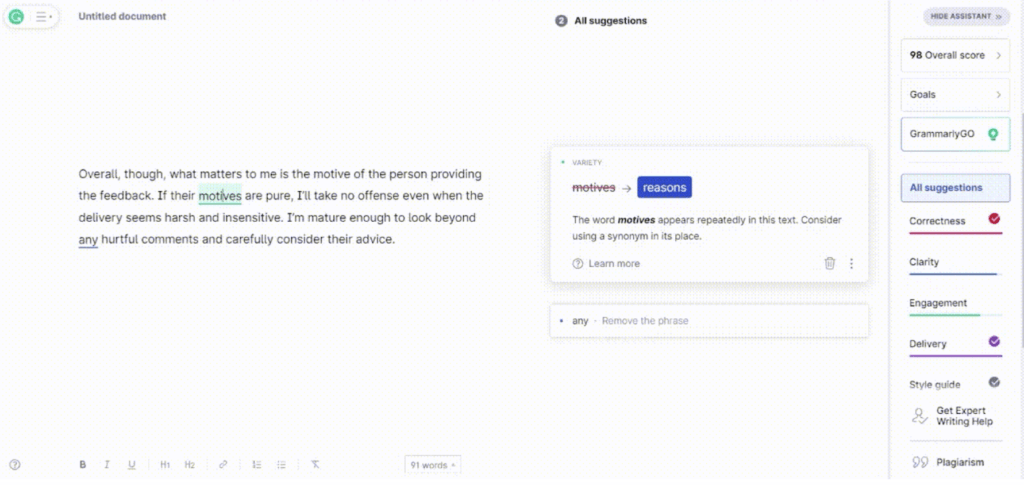
Grammarly suggested I replace “motives” with “reasons.” It also recommended I delete “any.” I disagree with the first suggestion. “Motives” more accurately conveys my intended message. But I agree that “any” is redundant.
When I ran the exact text through ProWritingAid, it didn’t flag “motives” or “any,” But as you can see below, it flagged “carefully consider” and suggested alternatives.
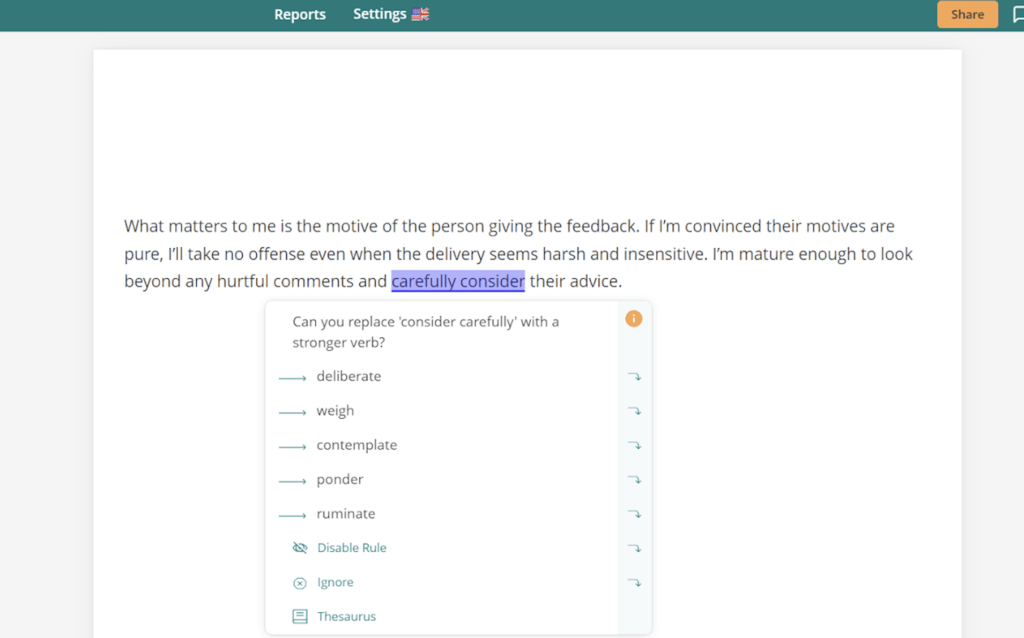
I agree the sentence reads better when I replace “carefully consider” with “ponder.”
Here’s the post-edit version of the statement:
“What matters to me is the motive of the person giving the feedback. If I’m convinced their motives are pure, I’ll take no offense even when the delivery seems harsh and insensitive. I’m mature enough to look beyond hurtful comments and ponder on their advice.”
Much better, right? However, I think combining both tools is a bad idea. They would be a time suck and increase your fees if you’re on the premium version of both tools.
Verdict: It’s a tie. ProWritingAid provides helpful suggestions that improve your writing, but not enough to make it significantly more accurate than Grammarly.
Customization Options
Grammarly gives considerable autonomy in customizing the suggestions you receive. For starters, its Set Goals feature ensures you receive writing suggestions tailored to the audience and context of your content.
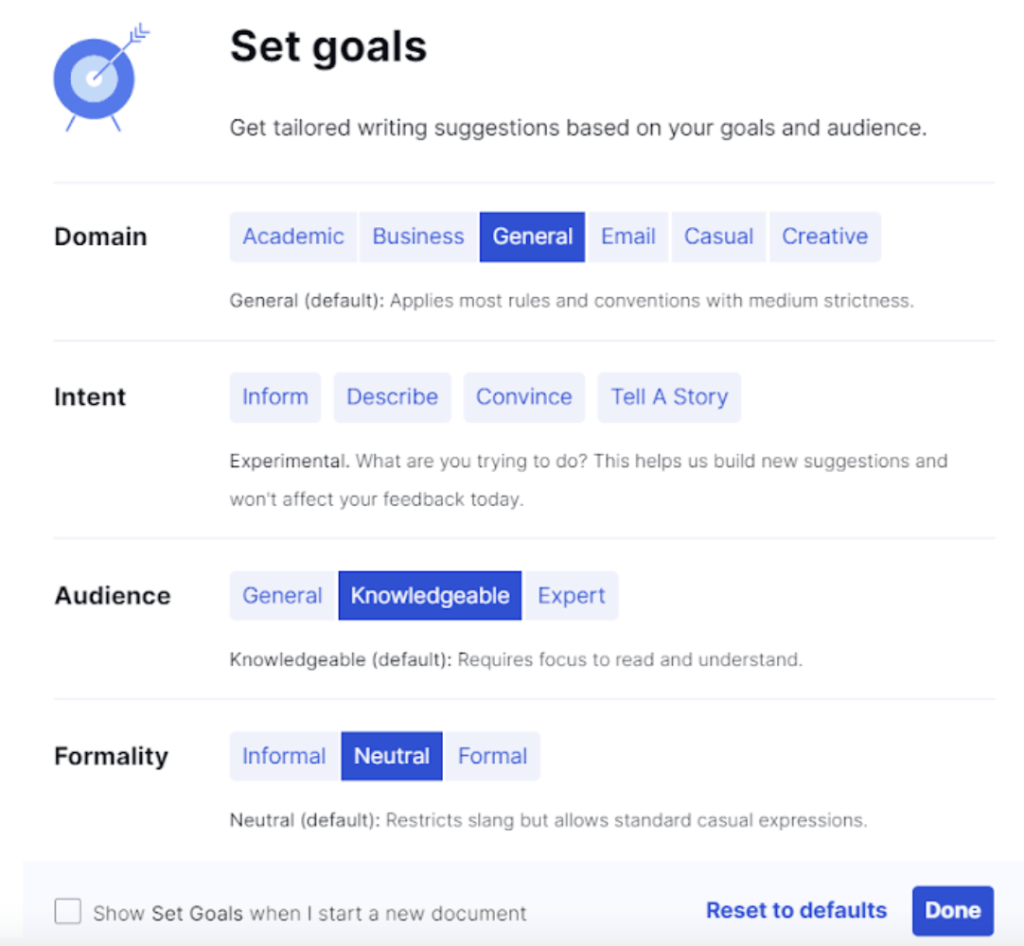
An academic paper, for instance, requires a formal writing tone. So using contractions or slang in this type of writing would be inappropriate.
Grammarly can help you catch informal language in your text if you set your Domain to Academic or Formality to Formal. Here’s an example:

Beyond these goal-based suggestions, you can activate or deactivate specific suggestions using Suggestions Management on Grammarly’s Editor Settings. For instance, you can turn off its “Avoid passive voice” feature, as seen in the image below:
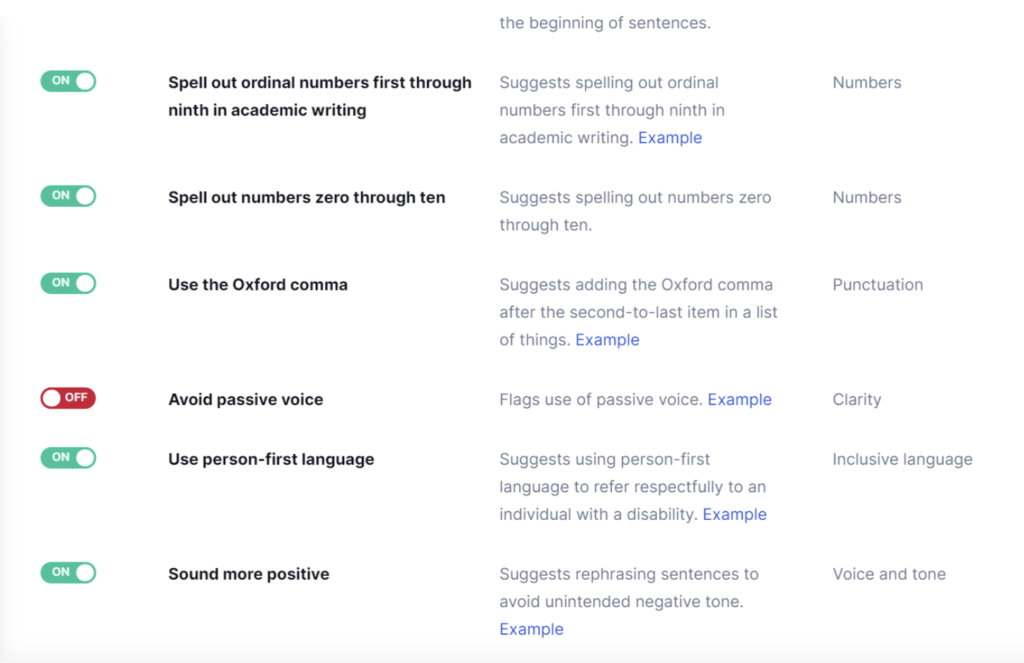
Grammarly also lets you create style guides, a valuable feature for businesses or agencies with multiple writers. This feature is exclusive to Grammarly Business subscribers.
The beauty of Grammarly is that it provides just enough options to help you feel in control, but not too much that you feel overwhelmed. Conversely, ProWritingAid features extensive customization options that could overwhelm a writer.
Like Grammarly, ProWritingAid lets you set your writing style and receive context-specific suggestions. But ProWritingAid gets a leg up because it has more writing styles. Plus, its Style Guide feature is available to all paid users.
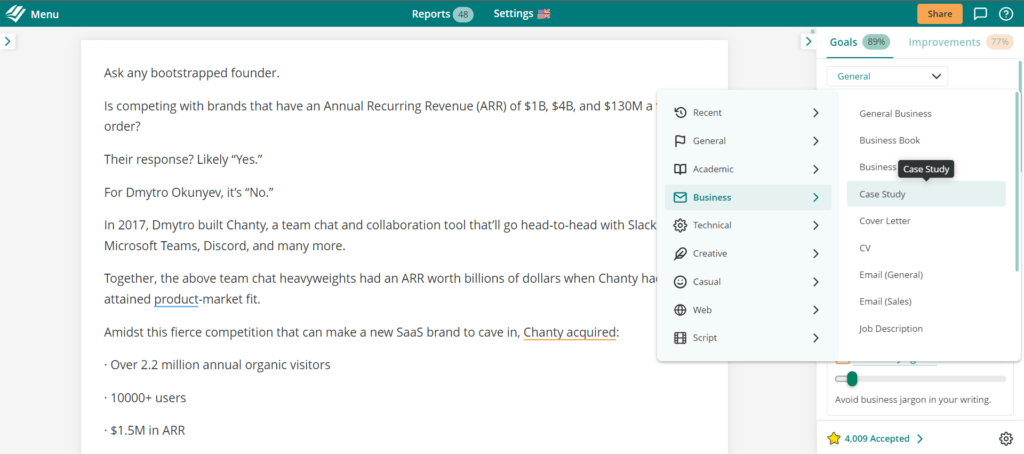
As shown in the image above, ProWritingAid writing styles are General, Academic, Business, Technical, Creative, Causal, Web, and Script. Each of these styles has sub-categories. So when you click on Business, for instance, you can choose the option that best fits your audience and goal.
Whereas Grammarly’s customization settings are universal, ProWritingAid sometimes lets you choose the document type to which you apply a customization rule. For instance, passive voice usage is common in academic writing. So you can set it to avoid passive voice in all documents except academic writing.
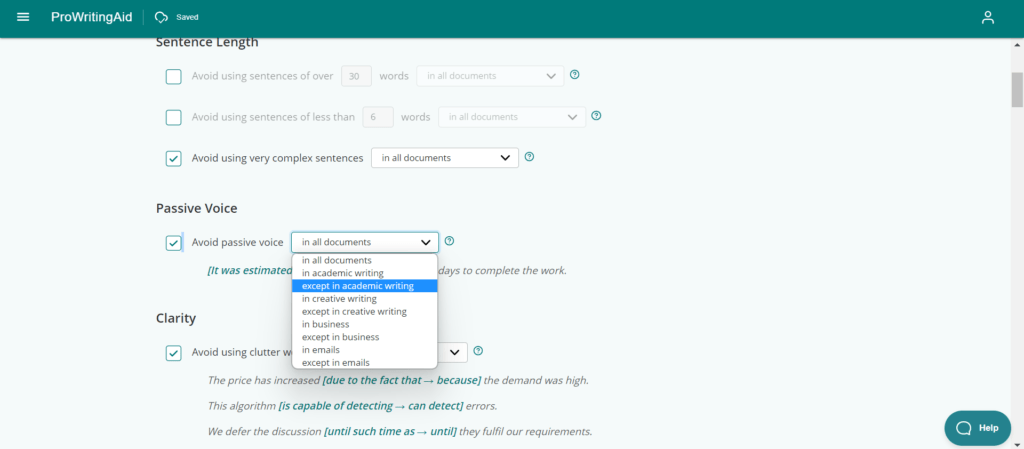
These extra details make ProWritingAid clunkier. But some writers (like me) appreciate the detail.
Verdict: ProWritingAid wins for extensive customization options.
Analysis Reports of Grammarly and ProWritingAid
Grammarly’s analysis report is basic at best. It includes your average sentence length, a readability score based on the Flesch Kincaid scale, and a bar indicating how your key metric compares to your other Grammarly users globally.

Grammarly also emails you a summary of these insights at the end of every week. Call me vain, but I pat myself on the back when Grammarly lets me know my week was more productive than 93% of its users.

The weekly email also contains three top mistakes I made in the previous week. That way, I discover and fix my bad writing habits. To access Grammarly’s analysis report, click Overall Score on the top right side of the web editor.
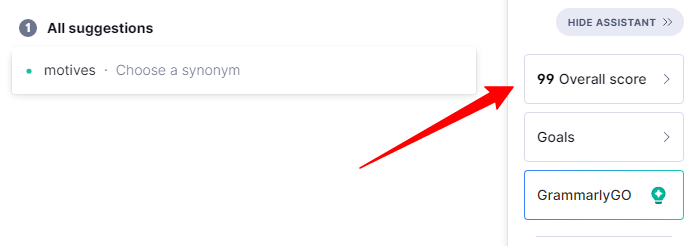
Analysis reports are where ProWritingAid best shines. Its summary report gives a detailed overview of your performance across 20+ categories, including grammar, style, readability, and sentence variety. The screenshot below cannot capture its true extent. For instance, this sample report actually spans an impressive 26 pages when printed.
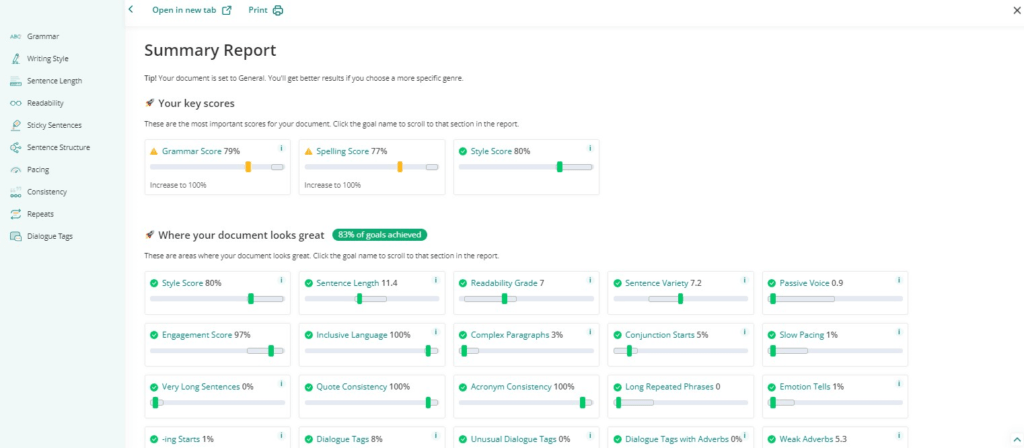
ProWritingAid also provides detailed reports on each writing category. Click the corresponding skill area in the Reports toolbar to access a report. The reports I often use are:
- Style Report: Highlights areas of your writing that you can revise to enhance readability. This includes passive voice, style improvements, nominalised verbs, and whatnots.
- Sticky Sentences Report: Flags sentences with too many glue words — like from, and, but, to, and in — prompting you to eliminate the stickiness and clarify your sentences.
- Repeats Report: Highlights frequently repeated phrases in your writing because repeating the words weakens your writing.
- Sensory Report: Highlights words that make the reader feel they are in the scene. For instance, if words like illuminate, foggy, crisp, and grasp dominate your writing, this report emphasizes your focus on sight and touch. So you may consider infusing words that appeal to the remaining three senses; sound, smell, and taste.
- Cliché Report: Helps you catch stale phrases and redundancies.
- Structure Report: Compares the structure of your writing with published articles in your industry. You can also use its Author Comparisons feature to compare your favorite author’s writing with yours.
What’s more, the bottom of each report includes a “More about this report” link.
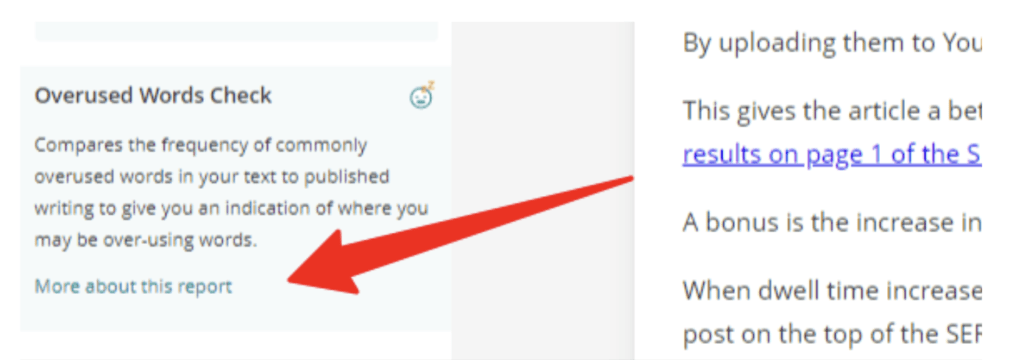
The link leads to an article that dives deep into the concept of that specific report.
Going through these reports and the accompanying resources is like having a private writing coach tutoring you to mastery. This thorough feedback and corrective training is ProWritingAid’s standout feature.
Verdict: ProWritingAid wins on analysis reports — it’s not even a contest.
Rephrasing Tools of Both Editing Software
ProWritingAid and Grammarly both provide quality rephrases using their generative AI functionalities.
To rephrase a text using Grammarly, highlight the relevant section and click the pen or green light bulb icon that appears.

You can choose from the premade prompts Grammarly suggests or type your prompt in the AI chatbot. I applied the “Improve it” Grammarly prompt to the introductory section of our post about comparison articles. This was the result:

The ProWritingAid rephrasing tool is also great, but it has two flaws. The first is that it provides only seven ways to rephrase your writing. You can ask it to add sensory detail, improve fluency so you sound like a native speaker, expand or shorten a sentence, make it formal or informal, or explore standard alternatives for the same idea.
Second, ProWritingAid can rephrase only one sentence at a time. When I highlighted a string of sentences and requested a rephrase, I had to click the next button to view the suggestions for each sentence.
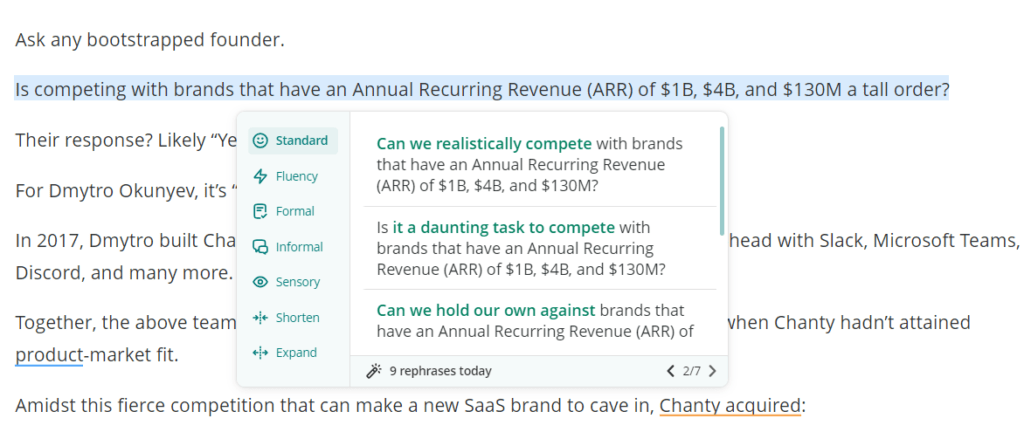
I suspect it didn’t consider the article’s context while doing the rephrasing. The result? Low-quality rephrases.
These tools are still in beta, so I expect improvements in the months ahead. But for now, Grammarly’s rephrasing tool is easier to use and has higher-quality rephrases.
Verdict: Grammarly’s rephrasing tool is superior.
Plagiarism Detection
Plagiarism could cost your studentship if you’re a student, your reputation if you’re a professional, or a ton of money if you’re an entrepreneur. That’s why it’s important to avoid it at all costs.
To determine the app that thoroughly identifies plagiarized content, I pulled 1,000 words of content from our post about comparison articles and ran a plagiarism check on Grammarly and ProWritingAid. Below are the results.
Grammarly Plagiarism Report
Grammarly detected 1% plagiarism.

ProWritingAid Plagiarism Report
ProWritingAid reported 25% plagiarism, stating that it found “16 non-original unquoted text parts.” Sure enough, it cited our site as the source.

These results suggest ProWritingAid plagiarism detection is more thorough. However, I found both results unsettling.
Here’s why:
We have since published the text we checked for plagiarism.
I expected the tools to detect more plagiarism. So I further investigated by running a plagiarism check on Copyscape and Plagiarism Detector, a free plagiarism checker.
Plagiarism Detector Report
Plagiarism Detector detected 79% plagiarism, and 73% of the source was our article. This free tool detected more plagiarism than ProWritingAid and Grammarly.
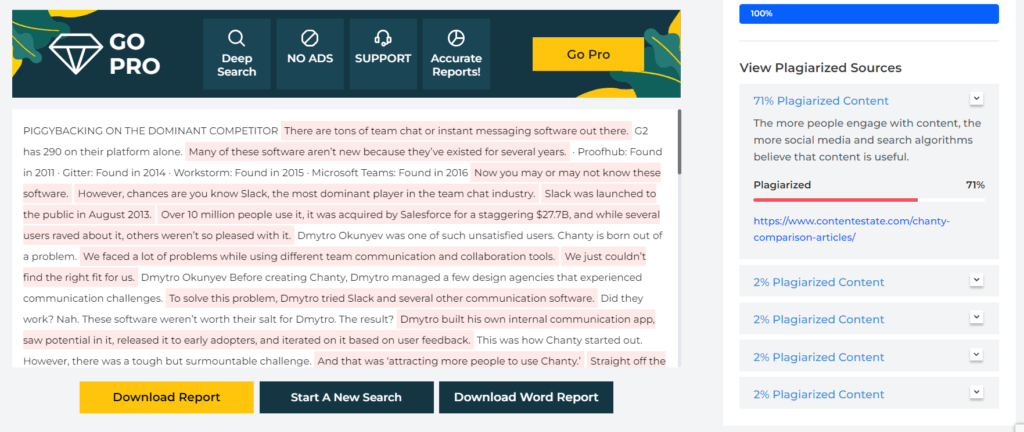
Copyscape Plagiarism Report
Copyscape Premium stood out of the pack, stating that 100% of the text matched content from our site, Content Estate.

If you’re hiring writers and you need a full-proof plagiarism checker, go for Copyscape. The plagiarism checkers in Grammarly and ProWritingAid aren’t worth their salt.
Verdict: It’s a tie. Plagiarism detection is weak and unreliable in both Grammarly and ProWritingAid.
Grammarly vs ProWritingAid Pricing
A monthly subscription for both Grammarly and PWA costs $30 each. However, PWA becomes cheaper than Grammarly as you move up the pricing tiers. The table below provides a closer look at the pricing structures of Grammarly vs. ProWritingAid.
| Grammarly | ProWritingAid | |
| Free Tier | Basic suggestions
No word count limit. No plagiarism check |
Provides basic checks
500 words limit 10 rephrases per day No plagiarism check |
|
For Individuals |
||
| Monthly Subscription | $30 | Without plagiarism checks – $30
With 60 plagiarism checks per year – $34 (Yearly billing gets you 67% off) |
| Quarterly Subscription | $60 (this translates to $20/month) | N/A |
| Yearly Subscription | $144/yr | Without plagiarism checks – $120/yr
With 60 plagiarism checks per year – $130/yr |
| Lifetime Payment | N/A | Without plagiarism checks – $399 one-time payment.
With plagiarism checks – $499 one-time payment. |
|
For Teams |
||
| Monthly Subscription | $25/member/month (minimum 3 members) | $12/user/month (minimum 2 users). |
| Annual Subscription | $180/member/yr
(minimum 3 members) (this equals $15/member/month) |
$144/user/yr
(minimum 2 users). (this equals $12/month) |
|
For Students and Academic Institutions |
||
| Student Discount | Varies based on time and source of discount | 20% off for individual students, educators, veterans, and non-profit |
| License for Academic Institutions | Available on request | Available on request |
Money-saving Hack: Premium plans for both editing tools drop up to 50% when these companies run flash sales. They run flash sales up to three times a year. If you sign up for your free Grammarly or ProWritingAid account now, they’ll notify you via email when a sale is on.
Note that Grammarly Premium includes plagiarism checks. With ProWritingAid, plagiarism checks cost extra, starting at $10 for 10 checks. Alternatively, you could buy their Premium Plus subscription, which includes 60 checks per year and costs $34/month or $130/yr.
The premium version of Grammarly also allows simultaneous access on a maximum of five devices. It’s not clear that PWA has such restrictions. I logged in to my PWA premium account on 7 devices before running out of devices to log in with.
Verdict: ProWritingAid wins the pricing round, as its premium plans are cheaper than Grammarly. However, Grammarly offers a more robust free package.
App Integrations of ProWritingAid and Grammarly
Grammarly doesn’t integrate with Scrivener, a popular writing software. And ProWritingAid doesn’t have a mobile app. However, both Grammarly and ProWritingAid have robust integration capabilities that cover frequently used work and study apps.
Below is an overview of Grammarly’s products and some apps they integrate with.
- Grammarly Desktop App for Mac and Windows: Works with numerous desktop apps, including Word, PowerPoint, Outlook, Mail, Slack, Discord, WhatsApp, and Evernote.
- Grammarly browser extensions: An extension for popular browsers, including Chrome, Safari, Firefox, and Edge. This extension provides suggestions on thousands of web pages, including Google Docs, Gmail, LinkedIn, Twitter, WhatsApp, and more.
- Grammarly Keyboard: This integrates with popular Android mobile apps, including Gmail, GoogleDocs, LinkedIn, Twitter, WhatsApp, and Chrome,
Note: The keyboard app often gets glitchy when using the Google Docs mobile app.
Below is an overview of ProWritingAid’s products and some apps they integrate with.
- ProWritingAid Everywhere for Windows and Mac: Works with many desktop apps, including Word, PowerPoint, Outlook, Mail, Slack, Discord, WhatsApp, Evernote, LibreOffice Writer, and Scrivener.
- ProWritingAid browser extensions: It has an extension for popular browsers, including Chrome, Safari, Firefox, and Edge. This extension provides suggestions on thousands of web pages, including Google Docs, Gmail, LinkedIn, Twitter, WhatsApp, and more.
- ProWritingAid for Microsoft Word and Google Docs: This plugin is built solely for Microsoft Word (desktop version) and Google Docs for a seamless editing experience.
Verdict: It’s a tie.
Which Should You Choose: Grammarly or ProWritingAid?
Grammarly’s biggest selling point is its aesthetic appeal. Its editing capabilities are decent, and its rephrasing functionality is superior. However, its analysis reports are shallow and seem more appropriate for students or general users. As a content marketer who has been a Grammarly premium subscriber for 2+ years, I feel like I paid a lot for less.
That said, Grammarly is for you if you value simplicity and elegance and do not need the thorough reports that Grammarly doesn’t provide. But if you want thorough analysis, feedback, and checks that’ll make your writing shine, then ProWritingAid is the better option.
Plus, ProWritingAid lifetime subscription saves you a ton of money. Lifetime plans for ProWritingAid Premium and its Lifetime Plus Plan cost $399 and $499, respectively. These two benefits are the reason we use ProWritingAid.
If you’ve tried none of these tools, I’d say take each one for a spin and see which you prefer. Remember that neither tool is a substitute for human editors. So whether you choose either tool, get the professional touch of editors if you can afford it.
Questions you may have about Grammarly and ProWritingAid
Are there editing tools that are better than Grammarly?
It depends on your basis of comparison. ProWritingAid is a strong competitor, but it’s not better all round.
Is the Grammarly free version any good?
Yes. The free version of Grammarly is manageable. But opting for the Premium version will serve you well.
Is Grammarly better than ProWritingAid?
It depends on your basis of comparison. In terms of pricing, ProWritingAid is better. For simplicity, Grammarly is better.
Is Grammarly premium for a year worth the cost?
I believe it is. But if cost is a concern, use ProWritingAid (especially the lifetime plans).
Damilare Olasinde

Damilare Olasinde is a content marketer for MarTech and EdTech brands. He helps businesses scale their content production efforts by crafting crisp, compelling, and idea-rich content that wins readers’ trust and drives search traffic.

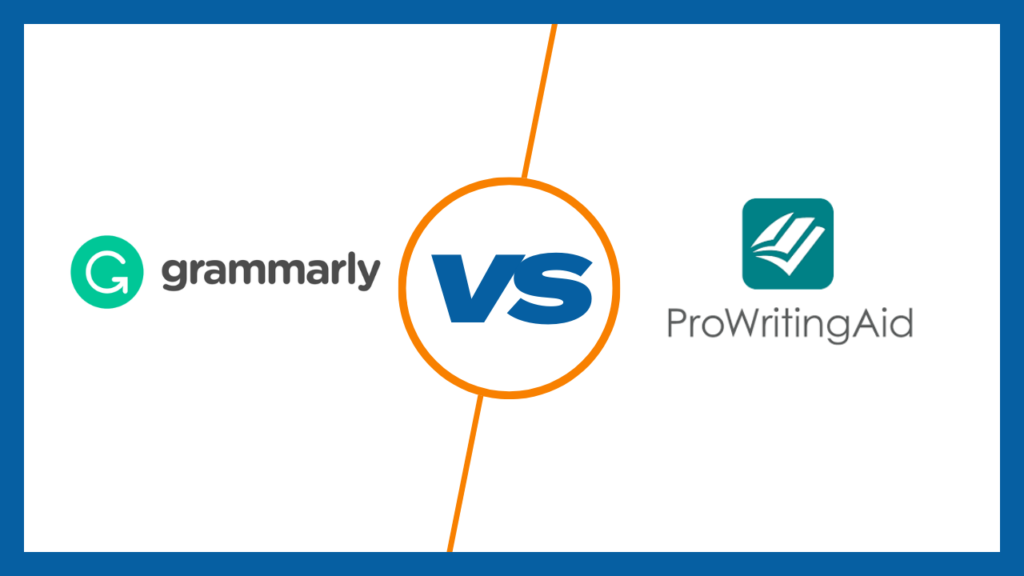
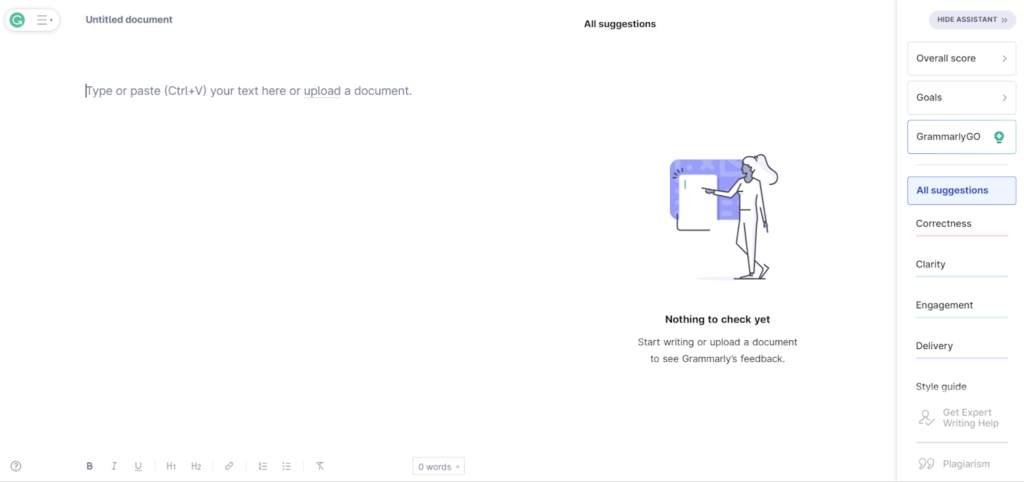
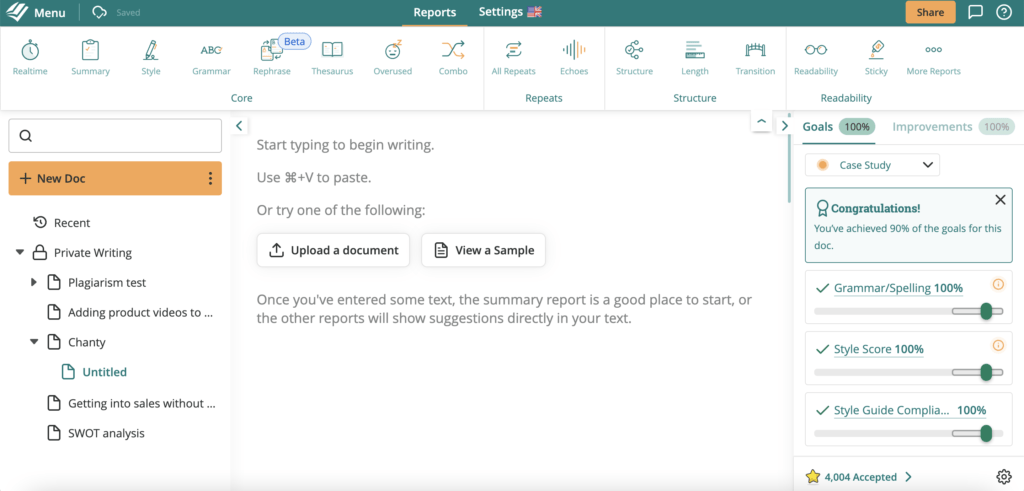



Leave a Reply
Want to join the discussion?Feel free to contribute!